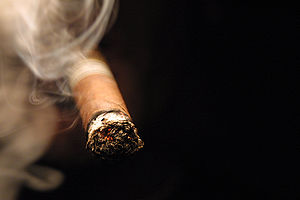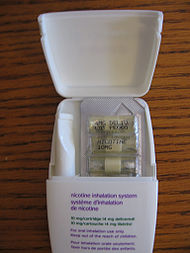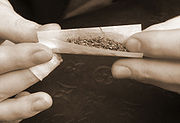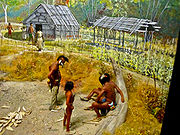Tobacco smoking
Smoking tobacco is a popular drug-consumption method wherein tobacco smoke in inhaled to uptake the nicotine. can lead to dangerous addictions that cause cancer or death. Every year, about four hundred forty thousand people die in the United States because of tobacco addictions, which is about twenty percent of all deaths in the United States. Cigarettes kill more Americans than AIDS, homicide, alcohol, car accidents, suicide, and illegal drugs combined. [1] Tobacco is formed with over four thousand chemicals, none of them beneficial one's health. The possibility of lung cancer increases with the amount of tobacco smoked, duration of smoking, degree of inhalation, and tar and nicotine levels of the cigarettes.[2] First used by North Americans, tobacco has been Europeans' favorite drug for many centuries. Tobacco quickly became famous due to its addictive chemical, nicotine. Nicotine disables the function of the brain, and therefore, smokers usually lose their sense. Cigarette flavors have gone through many changes since cigarettes were first made. At first, tobacco did not filter the tar coming through. Although fliters are now developed, they do not remove enough tar to make cigarettes any less dangerous. [3]
Compositions
The compositions in tobacco delivered to smoker depends on the length of the column of tobacco, the amount of compositions packed, characteristics of the filter and the paper, and the temperature of the fire at which the tobacco is burned. There are over four thousand chemicals in a cigarette, which includes 43 known toxic compounds that cause cancer, and 400 other toxins. Most of these chemicals stay in the lungs when inhaled. The gaseous phase components in tobacco are carbon monoxide, carbon dioxide, nitrogen oxides, ammonia, volatile nitrosamines, hydrogen cyanide, volatile sulfur containing compounds, volatile hydrocarbons, alcohols and aldehydes and ketones. They preclude the ciliary movement of the lungs.
Nicotine, highly addictive chemical, reaches the brain in just six seconds. Nicotine is a colorless and volatile liquid alkaloid. Nicotine stimulates the brain, and therefore, calms those who smoke tobacco. Once this lethal poison reaches the brain, it affects the heart, blood vessels, and hormones. Although smoking more makes it feel better, but it leaves great damage in the lungs and health of the body.
The other significant chemical in a cigarette is tar, which forms a sticky mass in the lungs. The amount of tar inhaled increases as a cigarette is smoked, therefore, the last puff of smoke contains more than twice as much tar as the first puff of smoke.
| Well known ingredients | uses and effects |
|---|---|
| Ammonia | household cleaner |
| Angelica root extract | known to cause cancer in animals |
| Arsenic | used in rat poisons |
| Benzene | used in making dyes, synthetic rubber |
| Butane | gas; used in lighter fluid |
| Carbon monoxide | poisonous gas |
| Cadmium | used in batteries |
| Cyanide | deadly poison |
| DDT | A banned insecticide |
| Ethyl Furoate | causes liver damage in animals |
| Lead | poisonous in high doses |
| Formaldehiyde | used to preserve dead specimens |
| Methoprene | insecticide |
| Megastigmatrienone | chemical naturally found in grapefruit juice |
| Maltitol | sweetener for diabetics |
| Napthalene | ingredient in mothballs |
| Methyl isocyanate | its accidental release killed 2000 people in Bhopal, India in 1984 |
| Polonium | cancer-causing radioactive element |
Just one cigarette leaves noticeable amount of tar in the lungs. Tar contains over four thousand chemicals, and smoking daily for a year leaves one quart of tar in the lungs.[4] [2]
Varieties
Clove cigarettes
Also called kreteks ("kree-teks"), clove cigaretts are imported from Indonesia and Southeast Asian countries. It has the same health risks as cigaretts, which contains sixty to seventy percent of tobacco and thirty to forty percent of oil, ground cloves, and other additives. It also contains more tar, carbon monoxide, and nicotine than a normal cigarette.
Flavored cigarettes
Also called as "bidis" or "beedies", flavored cigarettes are from South Asia. It has flavors of chocolate, strawberry, orange, licorine, and cherry, therefore, lures young people in the United States recently. It generally costs less than a normal cigarette, and therefore, few assumes it much safer and more natural. Bidis are rolled in a tendu or temburi leaf, plants native to Asia, and tied with strings on the end. It has more nicotine, the addictive chemical in tobacco, than a normal cigarrte, so a lot of people tend to look for the flavored cigarettes. Although it contains less tobacco, it delivers more harmful substances such as carbon monoxide, ammonia, and tar. It requires about three times more puff than a regular cigarette because it is thinner.
The government has banned flavored cigarettes as of October 2009, but it is still being used by younger smokers illegally. Young people who never smoked are easily addicted to this product by the non-harmful-looking images. But both clove cigarettes and flavored cigarettes are not safer than regular cigarettes, because each contains its own additional health problems.
Spit tobacco
Smokers place leaf tobacco in foil pouches and suck or chew: the use of spit tobacco. Chewing and snuff tobacco are two ways of 'spit tobacco' which do not require smoking. The user bites a small amount and places in the mouth. [5]
History
American Indians grew tobacco before Europeans came from Europe. Although tobacco smoking is common today, American Indians only smoked for special religious and medical purposes. In 1612, when first settlers came to North America, tobacco was the main source of making money for settlers. Money made by selling tobacco helped settlers pay for the American Revolution. The first president of the U.S., George Washington, grew tobacco also. By the 1800's, more people learned and started smoking. They used pipe generally while some chewed. People smoked about forty cigarettes in a year back at the time. In 1881, James Bonsack invented the machine that produced cigarettes, which let the world pay attention to tobacco. First cigarette brand was called Duke of Durham, and was packed with baseball cards. He worked with Washington duke's son, James Buck Duke. Together, they made about 10 million cigarettes per a year, and about one billion cigarettes in their next five years.
During World Wars, soldiers were given free cigarettes every day. Although tobacco was mainly sold to men, women became to know smoking while their husbands were away. Women smoked during their work time when their husbands went to fight.
By 1944, cigarette was produced up to three-hundred billion per year.
It was 1964 when smoking was proven harmful. The Surgeon General of the U.S., the chief doctor of the country, wrote how a cigarette can influence one's health. He stated that nicotine and tar in cigarettes cause lung cancer. Therefore, in 1965, every cigarette must have a warning sign, "Cigarette may be hazardous to your health." Later in 1980's, tobacco companies reduced the amount of nicotine and tar in a cigarette to keep their customers from their fear of smoking. "Tar wars" was called for this period of time, because many companies aggressively competed making low tar cigarettes.
[6]
Effects
Teens are vulnerable to tobacco's deadely effects. Smoking by youths can cause impaired lung growth, chronic coughing, and wheezing. Not only is nicotine addictive, but also poisonous. It can be used to treat crops, therefore, just one drop of a pure nicotine can kill a person. About 1,500 kids become smokers, and about thirty percent of them will die as a result. Smoking tobacco makes the lung and blood vessels narrower, puts a strain on the heart, leads to lack of oxygen and shortens breath. Due to its effects on the lung, smoke makes people run slower than nonsmokers. The secondhand smoke causes lung cancer and increases the possibility of illnesses in respiratory systems. The carbon monoxide causes cardiovascular diseases, and children who breath in tobacco are more likely to have ear infections, various allergies, bronchitis, pneumonia, and asthma. Therefore, children who have smokers in thier family get sick easily.
Health facts about smoking for teenagers
- Girls are more likely to grow excess facial hair if they smoke.
- Smoking 5 cigarettes daily may reduce teen's lung function.
- 40% of smokers quit and fail.
- More than half of teen smokers want to quit smoking.
- Teenagers who smoke break out more.
- Teenagers who smoke are more likely to get a cold than people who do not smoke.
- Smokers have trouble with sleeping.
- About one out of three smokers will die of smoking disease.
- Most people start smoking before they graduate high school.
References
- ↑ Radiation in Tobacco U.S. Environmental Protection Agency, July, 2010.
- ↑ 2.0 2.1 Tobacco Yaia.com , used in May 5, 2011.
- ↑ 3.0 3.1 Health Effects of Tobacco Healthy Maine Partnerships, 2008.
- ↑ Have You Ever Wondered What's In a Cigarette? Author, QuitSmokingSupport.com, January 2011.
- ↑ Child and Teen Tobacco Use Leo and Gloria Rosen, American Cancer Society, 2011.
- ↑ History of Tobacco First to the Last Ash: The history, Economics & Hazards of Tobacco, used in 05-09-2011.
| ||||||||||||||




